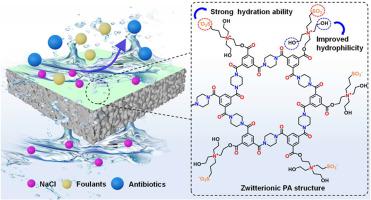两性离子三乙醇胺接枝纳滤膜用于抗生素的可持续回收
IF 9
1区 工程技术
Q1 ENGINEERING, CHEMICAL
引用次数: 0
摘要
随着对可持续发展的日益重视,膜技术已从废水处理扩展到高价值生物产品(如抗生素)的回收,为传统的溶剂提取和结晶提供了一种高效、低能耗的替代方法。在本研究中,我们将两性离子三乙醇胺(ZTEA)接枝在聚酰胺(PA)上,构建了一种高效的PA-聚酯纳滤膜(PA-ZTEA)。两性离子结构增加了膜的亲水性,增大了膜的孔径。与原始PA膜相比,改性PA- ztea膜的纯水渗透率(20.3 L m−2 h−1 bar−1)约为两倍,同时保持98%以上的红霉素(ERY)排斥。优化膜的NaCl/ERY分离系数为58.4,在模拟发酵液中连续运行的ERY浓度系数为2.95,显著优于原始PA膜(1.63)。此外,PA- ztea膜对蛋白质、多糖和表面活性剂表现出优异的防污性能(例如,十二烷基硫酸钠通量回收率为94.0%,而PA对照为84.5%),这是因为其水合层抑制了污染物的吸附。这项工作建立了一种有效的策略,以提高从发酵液中回收抗生素,解决海水淡化效率的关键挑战。本文章由计算机程序翻译,如有差异,请以英文原文为准。

Zwitterionic triethanolamine-grafted nanofiltration membranes for sustainable antibiotic recovery
With the increasing emphasis on sustainable development, membrane technology has extended from wastewater treatment to the recovery of high-value bioproducts (e.g., antibiotics), offering a high-efficiency, low-energy alternative to conventional solvent extraction and crystallization. In this work, we grafted zwitterionic triethanolamine (ZTEA) on the polyamide (PA) to construct a PA-polyester nanofiltration membrane (PA-ZTEA) for efficient antibiotic recovery. The zwitterionic structure increased membrane hydrophilicity and enlarged pore size. The modified PA-ZTEA membrane demonstrated approximately twice the pure water permeance (20.3 L m−2 h−1 bar−1) compared to the pristine PA membrane while maintaining over 98 % erythromycin (ERY) rejection. The optimal membrane exhibited outstanding NaCl/ERY separation factor (58.4), while it achieved an ERY concentration factor of 2.95 in the continuous operation in a simulated fermentation broth, significantly outperforming the pristine PA membrane (1.63). Moreover, the PA-ZTEA membrane exhibited exceptional antifouling properties against proteins, polysaccharides, and surfactants (e.g., 94.0 % sodium dodecyl sulfate flux recovery ratio versus 84.5 % for the PA control), owing to its hydration layer that inhibited foulant adsorption. This work establishes an effective strategy for enhancing antibiotic recovery from fermentation broths, addressing key challenges in desalination efficiency.
求助全文
通过发布文献求助,成功后即可免费获取论文全文。
去求助
来源期刊

Journal of Membrane Science
工程技术-高分子科学
CiteScore
17.10
自引率
17.90%
发文量
1031
审稿时长
2.5 months
期刊介绍:
The Journal of Membrane Science is a publication that focuses on membrane systems and is aimed at academic and industrial chemists, chemical engineers, materials scientists, and membranologists. It publishes original research and reviews on various aspects of membrane transport, membrane formation/structure, fouling, module/process design, and processes/applications. The journal primarily focuses on the structure, function, and performance of non-biological membranes but also includes papers that relate to biological membranes. The Journal of Membrane Science publishes Full Text Papers, State-of-the-Art Reviews, Letters to the Editor, and Perspectives.
 求助内容:
求助内容: 应助结果提醒方式:
应助结果提醒方式:


